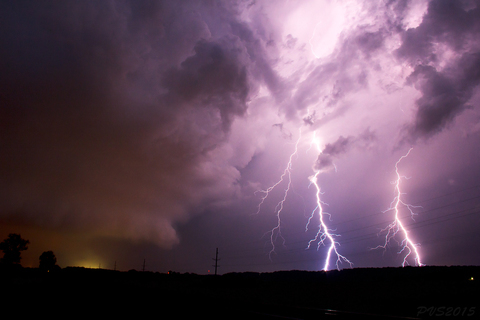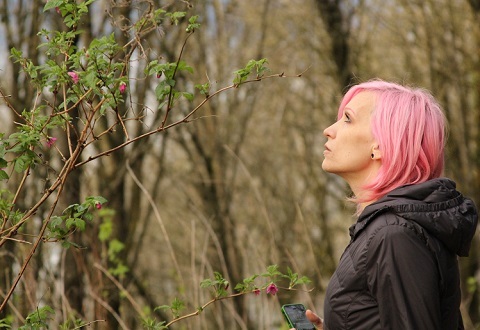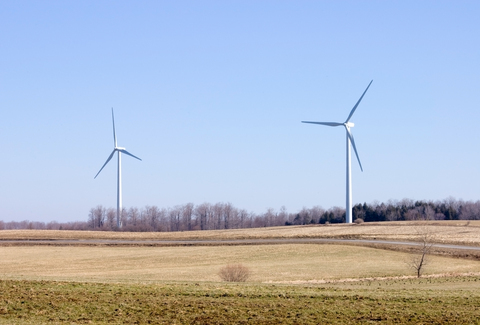David Suzuki's Blog, page 62
July 13, 2015
A look at North America's first regulatory restrictions on bee-killing pesticides

Happy Canada Day! Welcome North America's first neonic regulations. (Credit: Duncan Rawlinson via Flickr)
Ontario's ground-breaking regulatory restrictions on bee-killing neonicotinoid pesticides took effect July 1, 2015. Many David Suzuki Foundation supporters have written to us asking about the nitty gritty details. Let's take a closer look at what the new rules mean for Ontario and the rest of the country.
Q. Restrictions or ban? What's the difference?
A. Neonics are not altogether banned in Ontario. For one thing, the new regulation targets only neonicotinoid seed treatments and only for certain crops (grain corn and soybean). Other neonic products are not affected, including agricultural sprays and animal flea treatments. Likewise, seed treatments for other crops are not restricted. Furthermore, neonic-treated corn and soybean seeds, while generally prohibited, still can be used if certain conditions are met. Starting in fall 2016, farmers will need to submit a pest assessment if they wish to purchase and plant treated seeds. The pest assessment must follow established protocols and demonstrate the presence of relevant insect pests above established thresholds. The government expects that this system will reduce the use of neonic-treated corn and soybean seeds by 80 per cent by 2017.
The limited scope of the new rules is the main weakness of Ontario's approach. More comprehensive action to phase out neonics altogether would better protect the environment. Nevertheless, Ontario's targeted restrictions are a bold first step and a reasonable starting point. The federal Pest Management Regulatory Agency determined that planting neonic-treated corn and soybean seeds in particular led to reported incidents of sudden honeybee die-offs in Ontario and Quebec during the spring planting season, concluding that bees were likely exposed to neonic-laced dust from seeding equipment. Corn and soybeans are Ontario's two largest field crops, planted on close to five million acres. Virtually all Ontario grain corn and 60 per cent of soybean seeds are treated with neonics. Reducing this usage by 80 percent should mean three million more acres are neonic-free, and that's good news for bees.
Q. What is the timeline for implementing the new restrictions?
A. Although the new regulation entered into force on July 1, 2015, some requirements will be phased in over the next two years. In the first year, farmers will be able to purchase and plant neonic-treated seeds on up to 50 per cent of their corn or soybean fields without conducting a pest assessment. If farmers want to buy and plant neonicotinoid-treated seeds on more than 50 per cent of the total area of their corn or soybean crop, they will need to complete a pest assessment report and provide it to the seed vendor. Starting in 2016, a pest assessment report will be required for any purchase of neonic-treated seeds.
Once every three years, the pest assessment report must be prepared by an independent, third-party pest adviser, to improve accountability. This requirement does not kick in until August 2017, 2018 or 2019, depending on the region.
A final condition for the purchase and use of neonic-treated seeds is completion of a training course in integrated pest management, which will emphasize environmental considerations and alternatives to neonics. This requirement will take effect in time for the 2017 planting season, giving farmers a year to take the course. Farmers purchasing neonic-treated seeds will be required to submit a written declaration that IPM principles were followed.
Q. How will Ontario's new rules be enforced?
A. The new rules are subject to the general inspection and enforcement provisions in Ontario's Pesticide Act, although in reality the system relies to a large extent on the honour system to ensure pest assessments are valid, especially in the years when an independent third-party assessment is not required. Pest assessment reports must be submitted to the Ontario Ministry of Agriculture, and could be audited. Also, seed vendors are required to report annually on sales of neonic-treated and untreated corn and soybean seeds, and the regulation requires the government to publish a summary of this information online (the first summary report is due January 2017). This ensures an important measure of accountability for meeting 80 per cent reduction target.
Q. What about domestic neonic products, like lawn pesticides?
Ontario's Cosmetic Pesticides Ban Act of 2008 banned lawn pesticides containing neonics. (Nova Scotia also bans neonic lawn pesticides; other provincial cosmetic pesticide bans do not restrict neonics.) However, neonics could still find their way into your home and garden via treated bedding plants and houseplants or flea treatments for pets. Some major retailers have pledged to phase out the sale of plants that have been treated with neonics, or at least label them so consumers can make informed choices.
Q. Is Ontario's approach the model that other provinces should follow?
Ontario is the first jurisdiction in North America to introduce regulatory restrictions on neonics (although European governments have been quicker to act). Despite the limitations of Ontario's approach, this marks an important milestone in our continuing campaign to protect pollinators from toxic pesticides. An 80 per cent reduction in the use of neonic-treated corn and soybean seeds in Ontario will significantly reduce environmental contamination and encourage development of a market for safer alternatives. The David Suzuki Foundation is calling on other provinces and the federal government to meet or beat the standard Ontario has set.
Hey! Want more DSF? Join David Suzuki on Facebook

July 9, 2015
How to conserve water

A brown lawn isn't dead, just dormant (like a bear in winter). (Credit: Cindee Snider via Flickr)
It's hot. Many provinces are in flames and there's a water shortage.
Now, for the bad news: Our households consume about 340 litres of water per day. And the thirstiest culprit is your toilet, followed by laundry, faucets, showers and leaks.
This is not a problem of the week or this summer. This is what lies ahead.
Five water-saving habits inside your home (in order of impact)
Flush less
"If it's yellow, let it mellow..." is the two-part jingle. But what about all the other times?
Don't flush tissue or toilet paper each time you blow your nose. Switch to hankies (see laundering tip below).
Stop flushing the unflushables like baby wipes, floss and hair.
Install low-flow toilet(s). Old toilets use about 12 litres; low flow will cut that in half.
Launder less
Most clothing can be worn a few times before washing. Some people never wash denim!
Avoid using the pre-wash rinse cycle -- poopy cloth diapers a possible exception.
Invest in a water- and energy-efficient machine (savings are from 150 to 75 litres).
Faucets off!
Don't run the tap for a cold drink. Fill a jug and leave it in the fridge. Or drink what you get.
Wet your toothbrush. Then rinse the spit with waste water from your short shower (read below).
Use the water at the bottom of your salad spinner to give plants a drink.
Short showers
Set your phone alarm to two to three minutes. Or listen to a two-minute song ('cause I know you like to sing along). Turn the water off while you soap up.
Don't wash your hair every day.
Save shower water in a pail for washing floors, the car or rinsing toothpaste spit.
Fix leaks
Does your bathroom or laundry room smell mouldy? Check for leaks from big water sucks -- toilet(s), washing machine and faucets.
Metro Vancouver explains how to check a toilet: "Put a few drops of food colouring in the tank. If it shows up in the bowl, your toilet is leaking water."
Outside: Prioritize watering edibles over ornamentals and annuals
A brown lawn isn't dead, just dormant (like a bear in winter). Metro Vancouver recommends one hour of lawn watering per week (unless, of course, it rains).
Garden hoses are the least efficient way. Use a drip system or try clay pots!
Follow your city restrictions. Water in the early morning -- usually no wind and lower temperatures, so less water evaporates. The worst time to water is late evening because the lawn stays wet all night, making it more susceptible to disease.
Caught someone watering when they shouldn't? Read this before reacting.
What's a solution to saving water you think is underutilized?
Sincerely, Lindsay Coulter
A fellow Queen of Green
Hey! Want more DSF? Join David Suzuki on Facebook

Welcome to an extreme, warming world

(Image credit: PVS444 via Flickr)
My hometown, Vancouver, is in a rainforest, so we celebrate sunny days. People I talk to are enjoying the recent warm, dry weather, but they invariably add, "This isn't normal" -- especially with all the smoke from nearby forest fires.
With no mountain snowpack and almost no spring rain, rivers, creeks and reservoirs are at levels typically not seen until fall. Parks are brown. Blueberries, strawberries and other crops have arrived weeks earlier than usual. Wildfires are burning here and throughout Western Canada. Meanwhile, normally dry Kamloops has had record flooding, as has Toronto. Manitoba has been hit with several tornadoes and golf-ball-sized hail.
Unusual weather is everywhere. California is in its fourth year of severe drought. Temperatures in Spain, Portugal, India and Pakistan have reached record levels, sparking wildfires and causing thousands of deaths and heat-related ailments. Heavy rains, flooding and an unusually high number of tornadoes have caused extensive damage and loss of life in Texas, Oklahoma and Mexico.
The likely causes are complex: a stuck jet stream, the Pacific El Niño, natural variation and climate change. Even though it's difficult to link all events directly to global warming, climate scientists have warned for years that we can expect these kinds of extremes to continue and worsen as the world warms. Some hypothesize that the strange behaviours of this year's jet stream and El Niño are related to climate change, with shrinking Arctic sea ice affecting the former.
Several recent studies indicate a clear connection between increasing extreme weather and climate change. One, by climatologists at the National Center for Atmospheric Research in Colorado, looked at rising global atmospheric and sea-surface temperatures, which have increased water vapour in the atmosphere by about five per cent since the 1950s. According to the paper, published in Nature Climate Change, "This has fuelled larger storms, and in the case of hurricanes and typhoons, ones that ride atop oceans that are 19 centimetres higher than they were in the early 1900s. That sea-level rise increases the height of waves and tidal surges as storms make landfall."
A Stanford University study found, "accumulation of heat in the atmosphere can account for much of the increase in extreme high temperatures, as well as an average decrease in cold extremes, across parts of North America, Europe and Asia," but also concluded the influence of human activity on atmospheric circulation, another factor in climate change, is not well understood.
Earth is clearly experiencing more frequent extreme weather than in the past, and we can expect it to get worse as we burn more coal, oil and gas and pump more carbon dioxide and other greenhouse gases into the atmosphere. This can have profound and costly impacts on everything from agriculture to infrastructure, not to mention human health and life.
As Pope Francis pointed out, climate change and social justice are intricately connected: "The human environment and the natural environment deteriorate together; we cannot adequately combat environmental degradation unless we attend to causes related to human and social degradation."
That's why so many people from Canada and around the world are calling for action as government leaders prepare for December's UN climate summit in Paris: religious leaders including Pope Francis and the Dalai Lama; global organizations like the World Bank, International Monetary Fund, International Energy Agency and World Health Organization; businesses from Microsoft to Ikea to General Motors; and millions of people like those who marched for "Jobs, Justice and the Climate" in Toronto on July 5. All know the future of humanity depends on rapidly shifting the way we obtain and use energy.
Even though many world leaders recognize the problem, the recent G-7 agreement to decarbonize our energy by the end of the century is a horrifying joke. None of today's politicians making the commitment will be alive to bear the responsibility for achieving the target, and the time frame doesn't address the urgent need to begin huge reductions in fossil fuel use immediately.
Governments at the provincial, state and municipal levels have led the way in finding solutions. Now it's time for national leaders to finally demonstrate real courage and foresight as they gear up for the Paris summit later this year.
Hey! Want more DSF? Join David Suzuki on Facebook
David Suzuki to join Paddle for the Peace to stop Site C dam
David Suzuki is joining a list of distinguished speakers, including Grand Chief Stewart Phillip and Chief Roland Willson, at this year's Paddle for the Peace on the Peace River. Suzuki will join hundreds of people in canoes, kayaks and other watercraft to paddle down the Peace River to protest the imminent construction of the Site C dam. The B.C. government issued permits for dam-related construction this week despite growing calls for a moratorium.
When: Saturday, July 11, 2015
Event begins at 9 a.m. at the Halfway River with a pancake breakfast hosted by the West Moberly First Nations. David Suzuki will be available for media interviews at 10:30 a.m. at the Halfway River location and will give a speech at 2:30 p.m.
Where:
Boats will be launched into the Peace River at the Halfway tributary and finish at a third-generation farm that will be under water if the Site C dam goes ahead.
More information about the event: www.PaddleforthePeace.ca
Media contact
Faisal Moola, David Suzuki Foundation
1-647-993-5788
Hey! Want more DSF? Join David Suzuki on Facebook
Is climate change adding fuel to the forest flames?

(Credit: Sherwood411 via Flickr)
Sydney Crosby played many games in which he didn't score a single point. We don't judge him on these scoreless games, but on all the games he played over his career to know he's an extraordinary player. The same concept should apply to climate change. It is difficult to attribute individual forest fires to climate change in the same way it is difficult to attribute individual weather events -- such as heavy precipitation and flooding or extreme heat and drought-- to climate change. Yet we know that with higher temperatures we are experiencing more severe weather events, and more forest fires.
Natural Resources Canada reports that Canada's temperature increased 1.5 C between 1950 and 2010, and further warming is inevitable. The whole country is expected to have warmer temperatures, more and heavier rainfalls and extreme heat events, and less ice and snow cover. Canada is susceptible to all the effects of climate change, including more forest fires.
Forest fires need fuel, oxygen and heat. The warm weather dries out vegetation, creating fuel, wind provides the necessary oxygen and warmer temperatures enhance combustion. Dry, hot conditions are ideal for fires ignited by lightning. All these conditions are exacerbated by climate change and, over time, like Crosby's career, we see a remarkable increase in the number and size of forest fires.
In B.C. this year, 911 forest fires have been recorded. The average fire size over the past 10 years has been 58 hectares, but last year's forest fires averaged over 248 hectares. The trend this year toward bigger fires continues, with the average fire growing to 241 hectares early in the fire season.
This year's fire season arrived earlier than usual. Last year, B.C.'s fires did not spike until mid-July and lasted until the end of August. In Saskatchewan, this year's fire season also started with a vengeance: 582 forest fires already compared to 210 for all of 2014. The result has been devastating, with 54 community evacuations and poor air quality causing health concerns for those with respiratory and other illnesses.
This is shaping up to be a record year for fires across Canada. The southern boreal forest, stretching across Alberta, Saskatchewan and Manitoba, is also at greater risk from the effects of climate change, especially fires, according to a recent IPPC report. All western provinces have issued total fire bans and weather forecasts across the country call for more hot weather.
Fire prevention and other adaptation measures will be essential as we prepare for hotter and drier summers. Although most fires are started by lightning, almost 40 per cent are caused by people. Provincial campfire bans and fire prevention education are needed to bring this number down. We must act now to help our growing communities adapt by creating buffers between towns and cities and surrounding forests. Budgets and resources for firefighting must be increased to keep up with the new climate realities.
Forest fires aren't just a matter of chance. How we approach, and prepare for, the increasing numbers and severity of forest fires depends on the choices we make today to cut greenhouse gas emissions and act on climate change.
Hey! Want more DSF? Join David Suzuki on Facebook
David Suzuki Foundation Statement
The David Suzuki Foundation issued the following statement on progress at Ontario's Climate Summit of the Americas. Government leaders representing regions across the Americas, including Brazil, Mexico, the U.S. and Canada participated in the summit, which ended today.
The David Suzuki Foundation is encouraged by bold commitments coming from the Climate Summit of the Americas to address climate change. We need aggressive greenhouse gas emissions reductions like those developed by California (the Under 2 Memorandum of Understanding to limit warming to safe levels below 2 C) and supported by subnational leaders across three continents. Canadian provinces --including Quebec, Ontario, B.C. and Newfoundland and Labrador --and municipalities signing on are showing foresight in the lead-up to December's COP21 UN Climate Conference in Paris. Adding to the momentum, mayors representing 21 of Canada's big cities are also calling for binding targets to reduce GHG emissions.
Quotes:
"These mounting commitments by subnational governments in the lead-up to Paris show real climate leadership. The momentum is growing behind aggressive and effective targets and solutions that will make a difference," says Ian Bruce, David Suzuki Foundation science and policy manager.
"Pricing carbon, setting and meeting emissions reductions targets, phasing out coal-fired electricity and supporting transit improvements will be essential moves to tackle climate change. The commitments from the summit must be translated into action on some or all of these fronts if they are to be effective. Let's not forget, too, that some jurisdictions like Ontario still have further to go to meet previous commitments," says Karel Mayrand, director general of Quebec, David Suzuki Foundation.
Media contacts:
Ian Bruce
604.306.5095
Karel Mayrand
514-998-5458
Hey! Want more DSF? Join David Suzuki on Facebook
July 7, 2015
A term for that "I need time in nature" feeling

Time spent in nature cures irritability, reduces stress and makes people more generous. (Credit: Christopher Fassbender)
I asked you: If "hangry" is the anger you feel when you're hungry, what's the term for the irritability you feel when you're due for time in nature?
You came through with some creative, invented words and definitions. Let's vote for the best one! The winner gets a T-shirt signed by David Suzuki. (Plus, we'll all commit to start to use the term. It will be our little Queen of Green community inside joke.)
Crature • To crave nature. Submitted by Crystal.
Denatured • Deprived of nature. Submitted by Liz and Andrea.
Dysnatural • Submitted by Michelle.
Earth-ache • Submitted by Stacey.
Flora-Fauna-Fever • Submitted by Stacey.
Green-ache • Submitted by Stacey.
Hankergreen • When you hanker for time in a green space. Submitted by Karen.
Inature • Irritability when in need of nature. Submitted by Marilyn.
IrieNature • Submitted by Cheryl.
Irritreeted • Submitted by S.L.
Irrinaturability • Irritability when in need of nature. Submitted by Marilyn.
Mal-natured • Submitted by Michelle.
Natirable • When you become irritable and need time in nature. Submitted by Maureen.
Naturitable • Submitted by Danielle.
Nanky • Cranky due to a lack of nature. Submitted by Johanna and Kim.
Nature-ache • Submitted by Stacey.
Nilchy • Lack of nature inducing irritability. Submitted by Lynn.
Numpy • The nature-lacking grumps. Submitted by Emily.
Nunky • Submitted my Johanna.
Staleairis • Submitted by Cathy.
Treeprived • Submitted by S.L.
Don't forget to vote! Thanks to everyone who took the time to think about how important nature is to our well-being. (Voting closes July 21.)
Sincerely, Lindsay Coulter
A fellow Queen of Green
Hey! Want more DSF? Join David Suzuki on Facebook
July 3, 2015
Turning the dial down on risk from another Mount Polley
The decision on re-opening Mount Polley is imminent. B.C.'s chief inspector of mines says the government will implement the recommendations of the previously released independent panel report into the disaster.
Mining -- and resource development in general -- involves risk. Nowhere was that risk more evident than in the images of the tailings breach and environmental devastation from Mount Polley last year.
While B.C.'s Information and Privacy Commissioner let the provincial government off the hook yesterday in terms of its disclosure of information, the commissioner highlighted the need to re-interpret Section 25 of the Freedom of Information and Protection of Privacy Act so that urgent circumstances are no longer required to proactively disclose information that is in the public interest. The report found information the ministries had about the mine did not meet provincial requirements to share the risks to residents. However, they had information about two events that they could have disclosed.
The Mount Polley disaster demonstrated that we must do a better job of managing risk around all development projects in this province. If we don't want another Mount Polley it's essential that government ministries have adequate resources devoted to inspection, monitoring and enforcement. Costs for these must be shared with companies deriving the benefits from resource extraction. Companies should be required to post a fully paid security or bond that would cover the entire costs of environment cleanup in the event of an accident. Citizens and taxpayers alone must not be left to foot the bill for expensive cleanups.
Assessing the risk to public safety and possibility of harm to people or the environment is an important tenet of a sound approach to mining and resource-extraction projects in general. The risk to the town of Likely and the surrounding environment was enormous and impacts of the breach continue to come to light.
The commissioner's recommendations around proactive disclosure could be a good step, but there is a lot of subjectivity involved. Given government cutbacks to the very resources that would need to be activated for a rapid proactive response, it's difficult to hold out hope that this change alone will reduce risk to communities, the environment and people's health and safety.
The risk of more mining accidents -- and more environmental damage -- is real. The B.C. First Nations Energy and Mining Council found in a recent report that mining operations threaten more than 230 northern aboriginal and non-aboriginal communities and even the drinking water of Prince George, Terrace and Smithers. The report, Uncertainty Upstream: Potential Threats from Tailings Facility Failures in Northern British Columbia, found that 35 tailing ponds at 26 mines in 48 watersheds have the potential to affect fish-bearing waters in the region.
The decision on re-opening Mount Polley is imminent. B.C.'s chief inspector of mines says the government will implement the recommendations of the previously released independent panel report into the disaster. B.C.'s operating mines are required to provide letters to confirm the structure of their tailings ponds and the province is moving to establish independent tailings dam review boards. Whether these changes will be enough to turn the dial down on the risk of environmental disasters from mining operation remains to be seen. There is no doubt, however, that better monitoring, more inspections and greater transparency would better protect British Columbians.
Hey! Want more DSF? Join David Suzuki on Facebook
July 2, 2015
The new language of climate change

If nothing else, the G7 countries' recent agreement to end fossil fuel use for energy by 2100 signals a shift in the way we talk and think about global warming. Previous agreements were about reducing carbon emissions from burning coal, oil and gas. This takes matters a step further by envisioning a fossil fuel-free future.
There are reasons for cynicism: the long time frame means none of the politicians involved in the commitment will even be alive, let alone held accountable, for meeting the target in 2100; Canada and Japan watered down Germany's proposal to end fossil fuel energy by 2050; and many governments, including Canada's, haven't met even their current weak commitments. But in calling for deep emissions cuts by 2050 and an end to fossil fuel energy by 2100 -- "decarbonization" -- the non-binding pledge at least shows governments recognize the need to confront climate change.
Canada could show it takes the commitment seriously by heeding the advice of 100 scientists (including 12 Royal Society of Canada fellows, 22 U.S. National Academy of Sciences members, five Order of Canada recipients and a Nobel Prize winner, from a range of disciplines) who released a statement with 10 reasons why "No new oil sands or related infrastructure projects should proceed unless consistent with an implemented plan to rapidly reduce carbon pollution, safeguard biodiversity, protect human health, and respect treaty rights."
According to Simon Fraser University energy economist and statement co-author Mark Jaccard, "Leading independent researchers show that significant expansion of the oil sands and similar unconventional oil sources is inconsistent with efforts to avoid potentially dangerous climate change."
Another author, Northern Arizona University ecologist Tom Sisk, said it's not just about climate: "Oil sands development is industrializing and degrading some of the wildest regions of the planet, contaminating its rivers, and transforming a landscape that stores huge amounts of carbon into one that releases it."
The reasons for a moratorium include: oil sands expansion and investment are incompatible with climate protection and are slowing the shift to clean energy; monitoring and enforcement are inadequate; landscape is being contaminated and reclamation is insufficient; First Nations treaties are being violated; affordable alternatives are available; cumulative impacts have been ignored; and Canadians are demanding solutions.
Of course, it will take more than a non-binding pledge and slowing or halting oil sands expansion to avert the worst consequences of climate change. In an article in the journal Nature last year, eight scientists who signed the moratorium statement, including Jaccard, argued Canada and the U.S. must stop treating "oil-sands production, transportation, climate and environmental policies as separate issues, assessing each new proposal in isolation. A more coherent approach, one that evaluates all oil-sands projects in the context of broader, integrated energy and climate strategies, is sorely needed."
As part of a co-ordinated strategy, they proposed putting a price on carbon, through a carbon tax or cap-and-trade, to "ensure that the full social costs of carbon combustion are incorporated into investment decisions about energy and infrastructure." Carbon pricing is widely accepted as an effective way to discourage fossil fuel use and encourage clean energy development.
In future, people will look back and question why we burned such precious resources so wastefully. Fossil fuels are solar energy, concentrated over millennia and useful for numerous applications, many of which we probably haven't even discovered. Yet we've burned them largely so people, often solo drivers, can move around in tonnes of metal and plastic on land-destroying and expensive infrastructure. And we've used them to create increasing amounts of plastic packaging and unnecessary products that are now choking our oceans and land.
Moving toward zero carbon emissions -- in a much shorter timeline than agreed upon by Canada, France, Germany, Italy, Japan, the United Kingdom and the United States -- is absolutely necessary, and not just for the climate. Eliminating fossil fuel energy will cut dangerous pollution, create new economic opportunities and ensure resources are available for wiser applications.
The words of scientists, government leaders and other experts -- and now Pope Francis and the Dalai Lama -- make it clear that it's time to turn the page on this destructive and relatively recent chapter in our history. Now we must ensure our leaders strengthen and act on their commitments.
Hey! Want more DSF? Join David Suzuki on Facebook
Celebrities to join thousands of Canadians from 100+ groups at March for Jobs, Justice and the Climate
Jane Fonda, Joel Plaskett, David Suzuki among celebrities to march with thousands on July 5, on eve of the Pan American Climate and Economic Summits
Toronto -- At 1:00pm on Sunday, July 5 in front of the Ontario Legislature in Queens Park a broad coalition of more than 100 groups, representing hundreds of thousands of people across Canada will gather for the March for Jobs, Justice and the Climate. The march has attracted the attention and support of a number of celebrities including Jane Fonda, Joel Plaskett, and David Suzuki -- all of whom will be joining the march.
Fonda is a well-known and accomplished activist who has been involved with civil rights, anti-war, Indigenous sovereignty, and feminist movements for more than 40 years. She recently traveled to Vancouver to stand with First Nations fighting oil pipelines and tankers on the west coast.
"I am coming to Toronto to stand with First Nations, workers, and the powerful movement building solutions to the climate crisis. Indigenous people have been defending the land for centuries, they are on the front lines of climate change and fossil fuel extraction, but they're also showing us that real solutions are within our grasp if we have the courage to reach for them," she said. "When the workers in the oil and gas industry themselves are calling on their government to help them find cleaner jobs that don't burn the planet, you know we're ready for change."
Plaskett is a Juno Award winning Canadian rock musician and national icon originally from Lunenburg, Nova Scotia and based in Dartmouth. With his band The Emergency, he has toured throughout North America and Europe.
"I am attending this march because I am inspired by the activists and concerned citizens who are on the front lines, pushing against a rampant and dangerous fossil fuel driven economy," he said. "I think it's important to be involved and to send the message to our government that Canada should be leading the transition to renewable energy, not following corporate interests at the expense of our environment."
Both Fonda and Plaskett were recently inspired by Naomi Klein's book on capitalism vs. the climate, This Changes Everything -- and have decided to stand in solidarity with First Nations and workers this July.
David Suzuki is a scientist, broadcaster, author and co-founder of the David Suzuki Foundation. "We can and must change. People all over the world taking part in marches like the Toronto march know it. Religious leaders understand it. Global organizations such as the World Bank, International Monetary Fund and World Health Organization are talking about it. In Canada and elsewhere, municipal and provincial or state governments have been leading the way," he said. "As world leaders prepare for the global climate summit in Paris in December, it's time for them to join this growing, diverse groundswell of people who are showing the world the need and possibilities for a better way."
Other high profile march attendees include authors, activists, and musicians Tantoo Cardinal, Sarah Harmer, James Hoggan, Joanna Kerr, Naomi Klein, Stephen Lewis, Bill McKibben, Tom Rand, Judy Rebick, Jeff Rubin and Adria Vasil.
For more information: http://jobsjusticeclimate.ca/media/
- 30 -
Media contacts:
Graham Reeder
350.org, Canada communications coordinator
(647) 880-0786
graham@350.org
Sarbjit Kaur
Kaur Communications
416-274-5324
sk@kaurcommunications.ca
Hey! Want more DSF? Join David Suzuki on Facebook
David Suzuki's Blog
- David Suzuki's profile
- 247 followers



